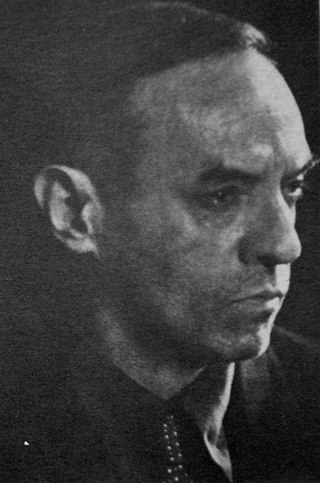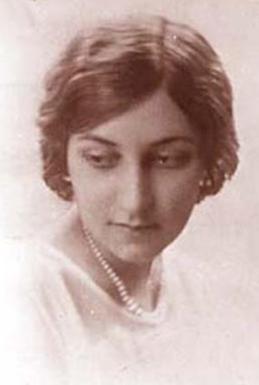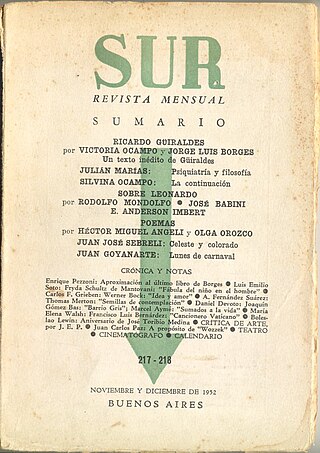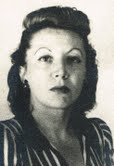Related Research Articles

Xul Solar was the adopted name of Oscar Agustín Alejandro Schulz Solari, an Argentine painter, sculptor, writer, and inventor of imaginary languages.
The Conservatorio Nacional Superior de Música is the national music conservatory for Argentina and it is located in Buenos Aires.

Leonor Fanny "Norah" Borges Acevedo, was an Argentine visual artist and art critic, member of the Florida group, and sister of the Argentine writer Jorge Luis Borges.

Sur was a literary magazine published in Buenos Aires between 1931 and 1992.
The Ultraist movement was a literary movement born in Spain in 1918, with the declared intention of opposing Modernismo, which had dominated Spanish poetry since the end of the 19th century.

Alfonsina Storni was a Swiss-Argentine poet and playwright of the modernist period.

Francisco Romero (1891–1962) was a Latin American philosopher who spearheaded a reaction against positivism.
Martín Fierro was an Argentine literary magazine which appeared from February 1924 to 1927. It was one of the leading avant-garde magazines in the country.

Ricardo Güiraldes was an Argentine novelist and poet, one of the most significant Argentine writers of his era, particularly known for his 1926 novel Don Segundo Sombra, set amongst the gauchos.

Guillermo de Torre Ballesteros was a Spanish essayist, poet and literary critic, a Dadaist and member of the Generation of '27. He is also notable as the brother-in-law of the Argentine writer Jorge Luis Borges.

Alejandro Korn was an Argentine psychiatrist, philosopher, reformist and politician. For eighteen years, he was the director of the psychiatry hospital in Melchor Romero. He was the first university official in Latin America to be elected thanks to the student's vote. He is considered to be the pioneer of Argentine philosophy. Along with Florentino Ameghino, Juan Vucetich, Almafuerte and Carlos Spegazzini, he is considered to be one of the five wise men of La Plata.

Arturo Carrera is an Argentine poet.
Manuel Gálvez was an Argentine novelist, poet, essayist, historian and biographer.

Ronald Shakespear is an Argentine graphic designer, mostly known for the Buenos Aires Visual Plan, designed along Guillermo González Ruiz in 1971–72. and other visual identity systems for several companies.

Jorge Aníbal Romero Brest was an influential art critic in Argentina, who helped popularize avant-garde art in his country.
Raimundo Lida (1908–1979) was an Argentine philologist, philosopher of language, literary critic and essayist. He specialised in Romance philology, aesthetics, the literature of the Spanish Golden Age and modernist literature. He taught at Harvard University from 1953, where he was chair of the department of Romance Languages. The second of three children, his siblings were the hematologist Emilio Lida and María Rosa Lida de Malkiel, also a philologist.
Oscar Abelardo Masotta was an Argentine essayist, artist, teacher, semiotician, art critic, and psychoanalyst. He was associated with the Torcuato di Tella Institute. He translated Jacques Lacan's works into Spanish and introduced his psychoanalytic philosophy to Latin America.

Caras y Caretas is a weekly magazine of Argentina published from 1898 to 1941 in its first period of existence. There was a previous version published in Uruguay between 1890 and 1897. Caras y Caretas was relaunched in 2005 under the direction of historian Felipe Pigna, having been published since then.

Nydia Lamarque (1906–1982) was an Argentine poet. In addition to publishing several books of poetry, she was a lawyer, activist, and translator. She was associated with the socialism and feminism movements.
Nora Domínguez is a full professor of literary theory at the University of Buenos Aires. She was a co-founder of the Instituto Interdisciplinario de Estudios de Género at the University of Buenos Aires, which introduced gender studies as an academic field in 1992. Between 2010 and 2017, she was the director of the institute. Her book De dónde vienen los niños. Maternidad y escritura en la cultura argentina won the Essay Prize from the National Arts Foundation. In 2021, she published El revés del rostro. Figuras de la exterioridad en la cultura argentina, which won the Humanities Prize for the Southern Cone from the Latin American Studies Association in 2022. She is currently directing a six-volume work to compile the series Historia feminista de la literatura argentina. The first volume in the series was released in 2020.
References
- 1 2 3 4 5 "Documents of the 20th Century Latin American Art". ICAA. Retrieved 14 April 2017.
- 1 2 3 Clara Alicia Jalid de Bertranou (2007). "Alejandro Korn in "Nosotros" magazine. Lectures from the past, contributions to the present: Homage in the 70th anniversary of his decease". Estudios de filosofía práctica e historia de las ideas (9): 89–104.
- ↑ Miranda Lida (2015). "El grupo editor de la revista Nosotros visto desde dentro. Argentina, 1907-1920". Historia Crítica (in Spanish) (58): 77–94. doi:10.7440/histcrit58.2015.04. hdl: 11336/70701 .
- ↑ Jorge Nallim (2012). Transformations and Crisis of Liberalism in Argentina, 1930-1955. Pittsburgh, PA: University of Pittsburgh Press. p. 110. ISBN 978-0-8229-6203-8.
- ↑ Mario Sartor. "Italian futurism and its Latin American echoes" (PDF). Seminário Internacional de Conservação de Escultura Moderna.
- ↑ Diana B. Wechsler; Antonio Bautista-Trigueros (2011). "Cosmopolitanism, Cubism and New Art: Latin American Itineraries". Art in Translation. 3 (1): 71. doi:10.2752/175613111X12877376766220. hdl: 11336/192548 . S2CID 193097558.
- ↑ John King (1986). Sur: A Study of the Argentine Literary Journal and Its Role in the Development of a Culture, 1931-1970 . Cambridge; London; New York: Cambridge University Press. p. 16. ISBN 978-0-521-26849-3.
- ↑ Jeane H. Delaney (August 2002). "Imagining "El Ser Argentino": Cultural Nationalism and Romantic Concepts of Nationhood in Early Twentieth-Century Argentina". Journal of Latin American Studies . 34 (3): 634. JSTOR 3875463.
- ↑ Vanessa Fernandez (2013). A Transatlantic Dialogue: Argentina, Mexico, Spain, and the Literary Magazines that Bridged the Atlantic (1920-1930) (Ph.D. thesis). University of California, Los Angeles. p. 6.